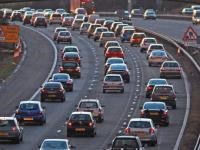This came through via the DSA newsfeed, although it has been covered by all the main media today. The problem is that no one in the media (or  anywhere else) seems to quite understand what it is they’re getting themselves all excited about. The BBC headlines the story by referring to “middle-lane hoggers” only, but tailgating is also involved.
anywhere else) seems to quite understand what it is they’re getting themselves all excited about. The BBC headlines the story by referring to “middle-lane hoggers” only, but tailgating is also involved.
Let’s just clarify what “middle-lane hogging” is, because the Audi drivers out there have already convinced themselves that this is going to keep at least two lanes open for their sole use in future. If you’re driving at 70mph on the motorway in the middle lane you are not hogging it if there is traffic to your left, or if you are likely to get boxed in behind that traffic if you were to move over into every gap. Unnecessary lane changing is probably more dangerous than moving steadily past slower traffic – and what motorway these days carries so little traffic that the left-hand lane isn’t fully occupied by slower-moving lorries and other vehicles most of the time? Let’s face facts here: if you’re driving along at 70mph, anyone who is travelling faster and catches up with you is breaking a much clearer existing law themselves, irrespective of which lane you’re in.
“Middle-lane hogging” is when (for example) someone is driving below the speed limit unnecessarily in the middle lane, perhaps (for example) going slower than the left lane, or maybe (for example) if they’re in it when there is nothing in the left lane at all – whether they’re driving at the speed limit or not. The term applies equally to people who drive in the third or outside lanes unnecessarily. The Highway Code is clear on the subject:
261
You MUST NOT exceed 70 mph (112 km/h), or the maximum speed limit permitted for your vehicle (see Speed limits table). If a lower speed limit is in force, either permanently or temporarily, at road works for example, you MUST NOT exceed the lower limit. On some motorways, mandatory motorway signals (which display the speed within a red ring) are used to vary the maximum speed limit to improve traffic flow. You MUST NOT exceed this speed limit.
Law RTRA sects 17, 86, 89 & sch 6
264
You should always drive in the left-hand lane when the road ahead is clear. If you are overtaking a number of slower-moving vehicles, you should return to the left-hand lane as soon as you are safely past. Slow-moving or speed-restricted vehicles should always remain in the left-hand lane of the carriageway unless overtaking. You MUST NOT drive on the hard shoulder except in an emergency or if directed to do so by the police, HA traffic officers in uniform or by signs.
Laws MT(E&W)R regs 5, 9 & 16(1)(a), MT(S)R regs 4, 8 & 14(1)(a), and RTA 1988, sects 35 & 186, as amended by TMA 2004 sect 6
“Tailgating” is technically any time when you are driving so close to another vehicle that you wouldn’t be able to stop safely if they braked hard (i.e. if you’re closer than two chevrons, where chevrons are painted on the road, or if you are not following the “two second rule”). However, even though driving too close is dangerous and anyone doing it deserves to be pulled over, the type of tailgating being being referred to is specifically the deliberate and aggressive kind intended to intimidate people and make them move out of the way. This aggressive form is a serious problem.
Another thing we should clarify is what these changes actually involve. At present, if the police saw someone tailgating or middle-lane hogging (which are already offences), they’d have to pull them over and then report them for processing by the courts. The process is slow and bureaucratic, and judging by what you see on Road Wars and similar shows, the police could have HD video footage from twenty different patrol cars of the guilty party driving within centimetres of another car, forty witnesses, and yet the case might still be thrown out as a result of “lack of evidence” or because some over-worked plod had spelled someone’s name wrong on a form.
But from July, instead of going down that route, the police will be able to issue roadside fixed penalties of £100 (with three-points attached) for careless driving offences such as those mentioned. Drivers will still be able to appeal through the courts. This is the only real change – as I said, all the offences mentioned were already offences before the change.
But it doesn’t mean that people need to start jostling to get into the left-hand lane every time they pass a lorry when there’s another one a few hundred metres ahead. Nor do they need to slam on their brakes and move over if they see a patrol car. Whenever we get a new law like this, everyone starts going on about the police trying to meet quotas for fines. But the simple fact is that you have to be doing something significantly wrong to get pulled over. Even now, the police can pull people over for using mobile phones and fine them/issue points, but they seldom do. All that’s happened is that tailgating and middle-lane hogging are now on the same list as mobile phones, and under the jurisdiction of the police.